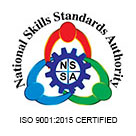Glossary of Terms used in Skills Assessment and Occupational Standard
The purpose of the glossary is primarily to provide a comprehensive list of the most up-to-date terms used in Myanmar for Skills Assessment and Occupational Standard Development. This glossary will be updated on a regular basis to ensure that further developments are included as they are introduced, and the international use of terms has also been considered.
|
Competency Element |
Refers to the basic fundamental parts of the standard. It describes the functions that a person, who works in a particular area of work, must be able to master. It must be described as actions or outcomes which are demonstrable and assessable. Written in action verbs. |
|
Competency Unit |
Refers to a competency which should be applied in a work situation, can logically stand alone and includes a title, expressed in action verbs. |
|
Competency Unit Code |
Refers to five components: 1) abbreviation of sector name, 2) abbreviation of occupation title, 3) occupational level, 4) total number of units, and 5) version of the standard |
|
Description |
Brief profile of the occupation indicating the purpose and intent for clear and accurate description of the standard. |
|
Evidence Guide |
Supports the assessment to determine if an individual held the competencies (specific skills and knowledge) described in the Standard. It relates to the knowledge and activities that should be demonstrated and observed to reliably attest to a person being able to apply a competency in a realistic workplace. |
|
Industry |
Also refers to as Sector. |
|
Occupation Title |
Mostly derived from the list of occupations found in the Myanmar Standard Classification of Occupations from the Department of Labour. |
|
Occupational Competency Standard |
The set of competencies required for effective performance in an occupation in line with the employers and industry requirements across the country |
|
Performance Criteria |
Statements which specify what is to be assessed and the required level of performance. Performance criteria also indicate the sequence of major tasks. Each element has a number of performance criteria describing in detail the skills a worker applies when undertaking the work defined in the unit. They set out fully what is done, how well the work should be performed and allow for a measurable outcome. Written in passive voice. |
|
Range |
Relates to the unit of competency as a whole and sets the parameters for the application of the competency and captures the, for example, the types of work, resources, services, etc. that could apply when the competency was being used. |
|
Underpinning Knowledge |
Refers to a basic understanding of how the work is done, which is a very vital part in evaluating the performance of workers. |
|
Underpinning Skill |
Refers to the essential abilities needed to perform effectively, which is a very vital part in evaluating the performance of workers. |
|
Unit Descriptor |
Elaborates the information provided by the Competency Unit by indicating the purpose and intent to ensure the clear and accurate description of such. |
|
Variable |
Refers to technical terms or processes identified in the Performance Criteria. |
|
Technical Competency |
Required for specific and key competency in concerned occupation |
|
Industry Competency |
Commonly required for concerned occupational cluster/ industrial area |
|
Basic Competency |
Generally required for whole/ all industrial areas and all employments) |
|
Competency Level |
Refers to the skills, knowledge and attitudes desired for semi-skilled workers or Level 2 workers. The description for each competency level can be found in the National Skills Qualification System. |
